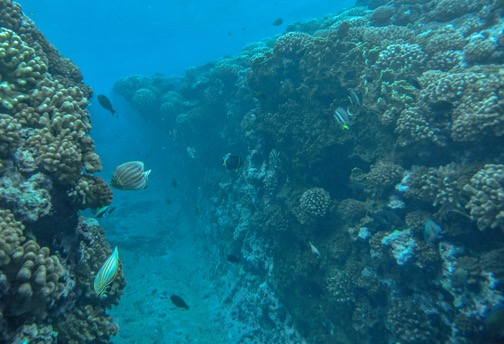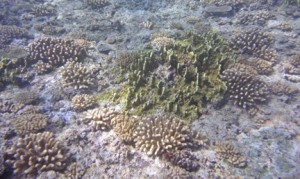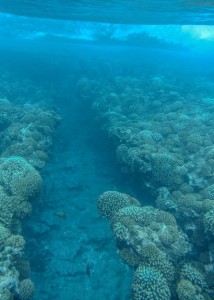CSUN Professor Takes Step Forward in Understanding Why Some Coral Reefs Recover from Devastating Events

Branching corals growing on a wave-cut channel on the outer reef of Mo’orea. These corals were wiped out by voracious swarms of the Crown of Thorns seastar and, following a major cyclone in 2010, they started to rapidly regrow from large numbers of babies that settled when adult corals were removed (i.e., settlement was negatively related to the abundance of adults, as described in CSUN marine biologist Peter Edmunds’ latest paper on coral reefs). Photo by Peter Edmunds.
California State University, Northridge marine biologist Peter Edmunds and a team of researchers have taken a step forward in understanding why some coral reef populations recover from catastrophic events.
Edmunds and his colleagues have found that density dependence — a scientific concept usually associated with understanding how the population sizes of animals and plants are controlled — can be applied to coral reef communities.
“You’ve got the ability for a population to grow, but then you’ve got what controls the rate of growth and the final size of the population,” Edmunds explained. “That control includes a whole bunch of processes — called the density-dependence effect— that play a critical role in determining the population size. The control of population sizes is front and center in climate change issues and the changing world that we live in. You can argue that the factors controlling population size, even with coral reefs, are fundamental to understanding the biological effects of climate change.”
Edmunds and his colleagues — Hannah Nelson, a doctoral candidate at the Center for Population Biology at University of California, Davis, who earned her master’s in marine biology from CSUN while studying with Edmunds, and Lorenzo Bramanti, a marine biologist with the Laboratoire d’Ecogéochimie des Environnements Benthiques in France — conducted an experiment that demonstrates the role that density dependence plays in the recovery of the coral reef populations in the reefs of Mo’orea, French Polynesia. Their paper, “Density-dependence mediates coral assemblage structure,” appears in the latest edition of Ecology.
In population ecology, density-dependence processes occur when population growth rates are regulated by the number of organisms in that population. The term, density dependence, is often used by scientists to better understand the factors controlling the development of complex communities.

Shallow coral reef on the outer shore of Mo’orea showing the branching corals that are the subject of Edmunds’ recent study. Bare carbonate rock is visible between them, and is the surface on which baby corals love to settle. The green coral in the center is “fire coral” which avoided being eaten by the Crown of Thorns Seastar. Photo by Peter Edmunds.
Edmunds and Bramanti first applied the concept of density dependence when they investigated the recovery of the coral populations on the reefs of Mo’orea following a massive infestation of coral-eating sea stars that, according to Edmunds, “pretty much killed off every coral on the reef” in 2010.
“It turned out that 2010 was the start of an absolutely remarkable recovery of the coral community,” he said. “In the course of just eight years, the reef has gone from basically no corals to about 75 percent of the sea floor covered by live coral.
“We published a paper [in 2016] that pointed out that this was really unusual and, at that stage, we suspected the recovery provided an example of density dependence at work,” he continued. “If you kill off the coral, you get phenomenally high densities of new baby corals appearing (a case of higher recruitment), and example of negative density dependence — which means when these corals die off, you get high recruitment, but as the population recovers, recruitment declines.”
The paper appeared in a journal about coral reefs and was read mostly by professional coral reef biologists. Edmunds and his colleagues realized that their paper was missing one key element that could attract the interests of more of their fellow scientists — an experiment that proved their theory was right.
In 2016, Edmunds, Bramanti and Nelson returned to Mo’orea and trimmed some corals from small plots of reef, altering the “density” of the corals in specific areas.
“We achieved exactly what we predicted would occur — we removed the coral and, sure enough, recruitment went up,” Edmunds said.
Applying density-dependence processes, which are regularly used in many aspects of ecological science, is much harder to apply to aquatic environments where the times researchers can work underwater is limited.
“It’s really difficult to work underwater,” Edmunds said. “If you work underwater for too long, you’ll die. If you stay underwater for sort of too long, you’re paralyzed. It’s not as easy as going into a forest and working there for 12 hours straight.”

Corals growing on a wave-cut channel on the outer reef of Mo’orea. Photo by Peter Edmunds.
But as marine scientists continue to study coral reefs over the course of years, if not decades, they are able to gather data and conduct experiments suggesting that the mechanisms controlling marine populations are similar to those controlling populations of plants and animals on the land.
“Many marine biologists have not been paying enough attention to what their colleagues in terrestrial biology are doing,” said Edmunds, who has spent the past 14 years studying the coral reefs off Mo’orea. “There’s a huge understanding of how a forest functions, and you can argue that some animals, like branching corals, can make underwater forests and, therefore, it is interesting to ask whether forests of trees and forests of coral are regulated by similar mechanisms.”
Edmunds said the density-dependences processes that applied in Mo’orea can provide marine biologists important information as they study ways to help coral reefs recover from disasters.
“If you can better understand the mechanisms that determine how a coral reef is put back together following a disaster, then you have a better chance of understanding how it might be put back together in a world with more intense hurricanes, perhaps fewer predators or possibly more diseases,” he said.
Edmunds, who also spent the past 32 years studying the reefs of St. John, U.S. Virgin Islands, said he did not think the density-dependence process he saw in Mo’orea would apply in the Caribbean.
“Most of the reefs in the Caribbean are so degraded that I think they are controlled by different rules,” he said. “Their rule book has changed because their communities have changed so much.”
Edmunds called the recognition that density dependence applies to many coral reef communities “a step forward” in understanding what may save them from the effects of climate change.
“Science advancement occurs down a very long road along which scientists are taking very small steps,” he said. “If you take enough steps, however, you can make a difference in understanding the way in which the biological world functions. I don’t know if we can take enough steps to understand the biological crises we are currently facing. That will depend on resources, public support and interest.”

 experience
experience